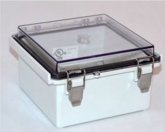Fish Freak
I fish frequently
My question will help many others, I'm sure, that are in the same boat;
Will's vids convinced me it'll be super simple to build my own LifePO4 power storage, not for solar, but for my fishing boat. I like the idea of DIY, learning, and using top quality parts compared to the 'cheap' drop-in lead-acid replacements. Found some great prismatic cells he tested, but then when I got to BMS I keep finding that they 'cannot be used in series' and no iPhone (android only) monitor app. I'm on the verge of giving up because I don't believe the Alibaba, ebay listings that say 'low temp protection' when Will proves that most don't work.
Who makes a battleborn grade BMS that also has a bluetooth app for iOS, not just android? A configurable app, not just to 'view' the SOC, Ah, etc.?
I run 4 group 27 to 31 big heavy lead agm batteries; 3 in series for 36v (or 2s for 24v) trolling motor (57 amp max draw) and one single 31 agm for starting a large boat engine (need burst, about 300 amps) and powering many electronic devices onboard all day. Going to LifePO4 represents a HUGE weight savings, and performance benefit. So what I'd like to understand is, why can't most BMS' be used in series? Why does a 12v BMS even care that it's in series? I could see if you were drawing AND charging in 36v like you would with solar, however, in our boats we use a 4 bank waterproof lithium charger that pushes say 20 amps to 4 leads, so each of the 4 batteries are recharged individually in 12v. Does charging individually in 12v negate that 'no series' warning?
My last goal would be to have one of my 4 DIY LifePO4 batteries be able to start an IC gas engine, needs roughly 300 amps for a quick burst, but then needs to power all sorts of electronics all day. So the BMS needs to be tough, right? Does one exist yet for a fair under $100 price? How about over $100?
Part of what's bugging me is there is a CHEAP $$ line of drop-in lead acid replacement batteries called Ionic, that can be used in series, can do the burst amps for starting an IC, and they have bluetooth, and I'm wondering HOW they're doing all that so cheap? I'd love to see Will cut one of them open!!
BTW I found some cool waterproof cases I think would be slick for battery cases with SEE_THRU tops, by Bud Industries, many sizes in their NEMA PTQ series:

Will's vids convinced me it'll be super simple to build my own LifePO4 power storage, not for solar, but for my fishing boat. I like the idea of DIY, learning, and using top quality parts compared to the 'cheap' drop-in lead-acid replacements. Found some great prismatic cells he tested, but then when I got to BMS I keep finding that they 'cannot be used in series' and no iPhone (android only) monitor app. I'm on the verge of giving up because I don't believe the Alibaba, ebay listings that say 'low temp protection' when Will proves that most don't work.
Who makes a battleborn grade BMS that also has a bluetooth app for iOS, not just android? A configurable app, not just to 'view' the SOC, Ah, etc.?
I run 4 group 27 to 31 big heavy lead agm batteries; 3 in series for 36v (or 2s for 24v) trolling motor (57 amp max draw) and one single 31 agm for starting a large boat engine (need burst, about 300 amps) and powering many electronic devices onboard all day. Going to LifePO4 represents a HUGE weight savings, and performance benefit. So what I'd like to understand is, why can't most BMS' be used in series? Why does a 12v BMS even care that it's in series? I could see if you were drawing AND charging in 36v like you would with solar, however, in our boats we use a 4 bank waterproof lithium charger that pushes say 20 amps to 4 leads, so each of the 4 batteries are recharged individually in 12v. Does charging individually in 12v negate that 'no series' warning?
My last goal would be to have one of my 4 DIY LifePO4 batteries be able to start an IC gas engine, needs roughly 300 amps for a quick burst, but then needs to power all sorts of electronics all day. So the BMS needs to be tough, right? Does one exist yet for a fair under $100 price? How about over $100?
Part of what's bugging me is there is a CHEAP $$ line of drop-in lead acid replacement batteries called Ionic, that can be used in series, can do the burst amps for starting an IC, and they have bluetooth, and I'm wondering HOW they're doing all that so cheap? I'd love to see Will cut one of them open!!
BTW I found some cool waterproof cases I think would be slick for battery cases with SEE_THRU tops, by Bud Industries, many sizes in their NEMA PTQ series:

Last edited:



